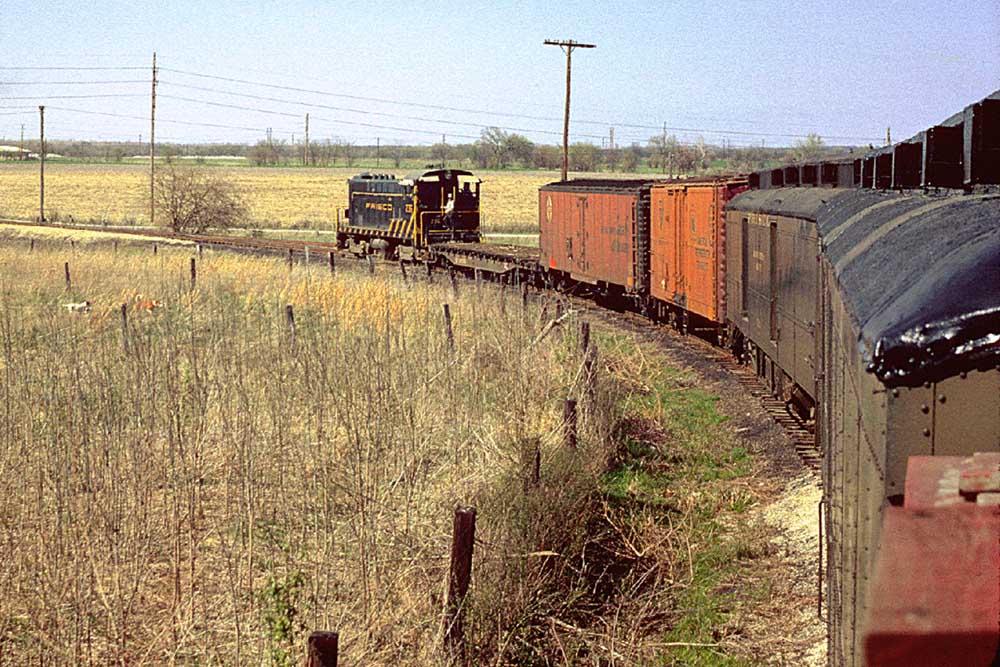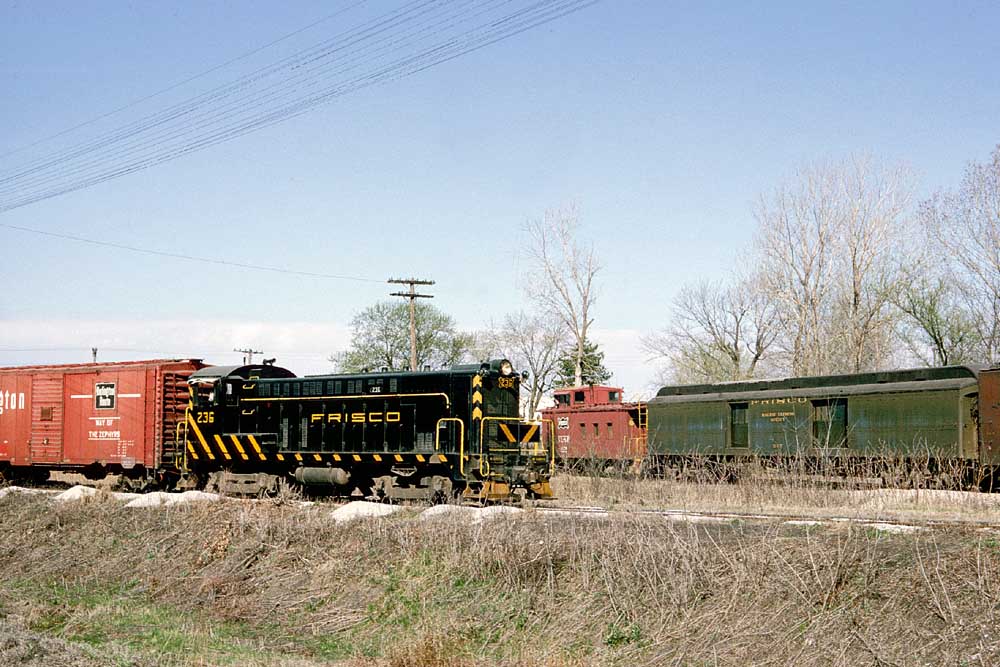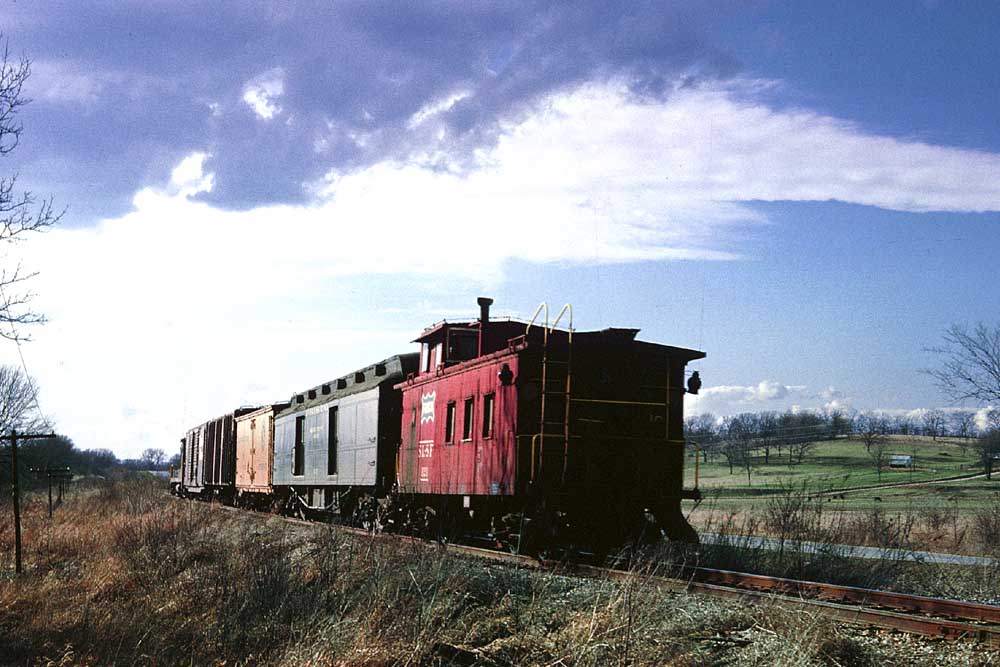A Frisco caboose ride provided a much needed railfan break during my military assignment near Kansas City.
My spirits fell when I received orders for my first U.S. Air Force permanent-duty assignment, at the Richards-Gebaur Air Force Base just south of Kansas City, Mo. I had hardly been west of the Appalachian Mountains, and relocating to the “big middle” didn’t sound very exciting to me. My outlook improved when I checked the Official Guide and learned that Kansas City was served by 15 railroads. Perhaps things wouldn’t be so bad, after all.
The Kansas City railroad scene did not disappoint. The year was 1962, and there was lots of what we came to call first-generation diesel power and bright paint schemes to be seen. Skirting the base was a secondary St. Louis-San Francisco Railroad line to Springfield, Mo., via Clinton, that paralleled the main line, some miles to the west, which went via Fort Scott, Kans. The Clinton Subdivision still hosted a mixed train, something that had disappeared long ago in my native East.

The train was in the timetable as No. 59 southward from Kansas City to Clinton and 58 northward on the return. Passengers were carried in the caboose, which I discovered to be an old wooden car. The only obvious visual clue that this wasn’t just another local freight was the one or two baggage cars carried in the consist just ahead of the caboose.
My friend from the East, Tom Underwood, eagerly sought out opportunities to ride obscure passenger services and get as many “green lines” as possible marked in his railroad atlas. So, in April 1965, about a year after I’d chased the mixed a couple of times, Tom journeyed west to join me to ride the train.
On April 19, we caught No. 59 at Belton, Mo., a flag stop 28 miles south of its starting point of Frisco’s 19th Street yard in Kansas City’s West Bottoms, a mile west and north of Union Station. In fact, all stations on the line were listed as flag stops since passengers were anything but a high priority on the route. Frisco had discontinued real passenger service here in 1953.
We boarded the caboose, and conductor Wilson issued us cash receipts for $10.87 each for round-trip tickets. Tom naturally headed for a seat in the cupola, but Wilson cautioned that he might not want to sit up there, saying, “Every once in a while the country boys like to take a shot at the train, and the caboose is a prime target.” So, for the southbound trip, at least, we settled for a view out the caboose’s back door. The speed limit on the branch was 35 mph.
The first stop for switching work was at Harrisonville, where there was a long siding that crossed the Missouri Pacific’s Carthage Subdivision on a diamond to reach several customers. The siding was a remnant of a Missouri-Kansas-Texas branch line that Katy had abandoned in 1958. Beyond that was a second diamond where the Frisco main track crossed the MP again. A swinging gate protected the MoPac on the spur, and 59’s crew had to call for permission to open the gate before they could shove three boxcars to their delivery spots.

We arrived in Clinton in late morning. Our power, Baldwin VO1000 236, was spun on the turntable and disappeared down the track to do some local work. We wandered off for lunch and were back at the depot in plenty of time for the 2:30 p.m. departure. Now there were two baggage cars in the consist, full of boxes of hatchlings from local chicken farms. This traffic was why the mixed service had survived. Several creative station agents solicited lucrative local Railway Express business, including puppies from several dog breeders as well as the chicks.
Another contributing factor to traffic on the branch was “off-line shippers” working the rail tariff system to their advantage, according to B. C. “Billy” Davidson, a trainmaster on the route in the 1950s. The shippers would cleverly route loaded cars not yet consigned to the ultimate receiver to interchange points on secondary and branch lines. These cars with phantom consignees — lumber was one common commodity — were sometimes called “rollers,” serving as de facto warehouses until a buyer could be found for the contents.
With limited through service on secondary routes such as this one, cars often sat for days, extending the free warehousing for the shippers. Harrisonville, being a Frisco-Missouri Pacific interchange point, was a favorite. With limited service and possibly none on Sunday, a routing through Harrisonville could tie up cars for days and cause it to take weeks to move over the railroad network. This was bad for car utilization and expensive for railroads, but an accepted practice until the late 1970s.
As I recall, our train did little to no work on the return trip. I detrained at Belton, where my car was parked, but Tom rode on to Centropolis, a mile south of the big Sheffield junction on the east side of Kansas City, the western limit of passenger service Frisco offered on the branch. The train continued on from Centropolis using Kansas City Terminal Ry. tracks across the city to reach its home yard.

Since I took no notes, many details of this trip made four decades ago are now a bit fuzzy. Interestingly, a friend recently purchased a Frisco Eastern Division Employee Time Table 43, effective Dec. 3, 1961. On the Clinton Subdivision table someone, possibly a railroad official, had made notes during a June 28, 1962, ride on the mixed to Clinton and back, detailing where orders were picked up, cars dropped, and “horrible” track-gauge and alignment problems south of Harrisonville. The train had VO1000 231, caboose 96, and 10 cars out of Kansas City. Reading the annotated timetable brought back a lot of memories of our trip.
The notes mention dropping three cars at my Air Force base, whose station was Belvidere. Gosh, I lived on the base for three years and don’t remember the railroad sidings! Later Frisco track charts, from 1979, show three stub tracks and a run-around serving a spot for explosives (air-to-air missiles, I suspect), a fuel-unloading rack, a warehouse, and a cold-storage building. I guess I didn’t know the line as well as I thought I did. I should have taken notes like our mystery rider did.
The mixed continued to run until 1967. A decade later, a trestle north of Blairstown burned, and freight service was cut back to East Lynne; it ran into the 1980s.














Thanks for that interesting tale.
Here in NSW (Australia) mixed freights disappeared 40 years ago but in the early 90’s I made a trip from Brisbane (Qld) to Dirribandi before the line closed, riding in what we called the Guard’s Van on the rear. This car also was eliminated with the move to container traffic only.
I sat at the rear door with my little Gaz burner and made coffee and heated cans.
Like you, I have nostalgic memories of these quirky long gone adventure rides.
David Donne Lismore NSW
Nice article!